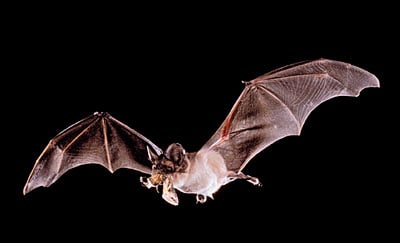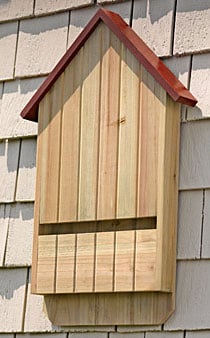All About Bats
 A Mexican free-tailed bat captures a moth. This species is common in backyards in western and southern states.
A Mexican free-tailed bat captures a moth. This species is common in backyards in western and southern states. Photo: © Merlin D. Tuttle, Bat Conservation International
By Nina Fascione, Executive Director, Bat Conservation International
Each night, as darkness falls, legions of bats go to work around the world. They perform a range of tasks that are essential for healthy ecosystems and human economies. And yet, these wonderfully beneficial flying mammals are among the most reviled and needlessly feared of creatures, victims of centuries of myth and misinformation that threaten bats and their habitats. Bat Conservation International has been combining education, research and conservation to protect bats worldwide since 1982.
The more than 1,200 species of bats — about a fifth of all mammal species — are incredibly diverse. They range from the world's smallest mammal, the tiny bumblebee bat that weighs less than a penny, to giant flying foxes with six-foot wingspans.
Bats are primary predators of night-flying insects, including many of the most damaging agricultural pests, as well as bugs that bedevil backyard gatherings. A single little brown bat can eat up to 1,000 mosquito-sized insects in a single hour. The millions of Mexican free-tailed bats at Bat Conservation International's Bracken Cave in Texas eat up to 200 tons of insects each summer night. And a favorite target is an especially damaging insect called the corn earworm moth. Scientists recently estimated that bats save American farmers at least $3.7 billion (and perhaps as much as $53 billion) a year in reduced crop damage and pesticide use.
Bats have a secret weapon in their war against bugs: a biological sonar system called echolocation. Flying at high speeds, they hunt insects and avoid collisions even in total darkness by sending out ultrasonic beeps and analyzing the echoes that come bouncing back.
Other bat species feed on fruit or nectar. These are critical pollinators of such valuable plants as wild bananas, avocados, dates, figs, peaches, mangoes, durian, cloves, cashews, carob and balsa wood. Fruit bats are also seed dispersers that are so important for restoring cleared rainforests that they've been called the 'farmers of the tropics'.
And by the way, only three bat species are vampires and they're all in Latin America. Vampire bats really do feed on blood, although they lap it like kittens rather than sucking it up as horror movies suggest. Even the vampires are useful: an enzyme in their saliva is a powerful blood-clot dissolver that is used to treat human stroke victims.
Despite all these benefits, bat populations are declining around the world as they lose habitat to agricultural and urban expansion, face repeated disturbances to their roosts and are frequent victims of vandalism and bushmeat hunting. Now, in North America, bats face the devastation of White-nose Syndrome, a wildlife disease that has swept across the eastern United States and Canada killing more than a million bats in five years.
 This bat house will accommodate about 30 bats.
This bat house will accommodate about 30 bats.How to Welcome Bats in Your Backyard
Most gardeners should consider installing a relatively inexpensive bat house, even in cities. Your tenants will repay you by patrolling the area for insects that might be casting a hungry eye at your veggies. You'll also enjoy watching bats commute back and forth to the home you provided.
Bat House Basics
The odds of attracting bats are very good if you set up a well-designed, well-built bat house, mounted according to recommendations developed by the Bat House Project. These tips are the result of 12 years of research by volunteers from across the U.S., Canada and the Caribbean.
- Bats inhabited an average of 60 percent of all reported bat houses — both good and bad houses and installations.
- Occupancy in rural areas was 61 percent, compared to 50 percent in urban and suburban areas.
- 90 percent of occupied bat houses were used within two years (with 50 percent occupancy in the first year). The rest needed three to five years for bats to move in.
- Tall designs, such as multi-chamber (nursery) and rocket-style houses, performed best.
Attracting Bats
Bats have to find new roosts on their own. Existing evidence strongly suggests that lures or attractants (including bat guano) will not attract bats to a bat house. Bats investigate new roosting opportunities while foraging at night, and they are expert at detecting crevices, cracks, nooks and crannies that offer shelter from the elements and predators. Bat houses installed on buildings or poles are easier for bats to locate, have greater occupancy rates and are occupied two and a half times faster than those mounted on trees.
Unlike domestic animals, bats are wild and free-ranging. It is usually illegal to buy or sell them, and permits to capture and possess bats are generally limited to researchers, zoos, wildlife rehabilitators and educational organizations. Catching and relocating bats to new areas is, in any case, highly unlikely to succeed. Bats have strong homing instincts, and once released into a bat house, will attempt to return to their former home area. If a bat house remains unoccupied after two years, consider repositioning the house.
Proper Temperature is Key
Maintaining the proper roost temperatures is probably the single most important factor for a successful bat house. Interior temperatures should be warm and as stable as possible (ideally 80 to 100 degrees F in summer). Some species, such as the big brown bat, prefer temperatures below 95º F, while others, such as the little brown bat, tolerate temperatures in excess of 100º F. Bachelor bats are less picky and may use houses with cooler temperatures. The sides of wooden or masonry structures are the best mounting sites, especially in colder climates, because temperatures are more stable than for bat houses attached to poles.
Bat house temperatures are influenced directly by the exterior color, compass orientation (east-, southeast-, or south-facing are generally good bets for single houses in most climates), the amount of sun exposure, how well the house is caulked and vented, and the mounting and construction materials.
You may have to experiment to get the right placement and temperature range. To check the temperature, use a thermometer taped to a pole.
Print this Article:
Get the Dirt
Stay up to date on new articles and advice. Please fill out the information below.
